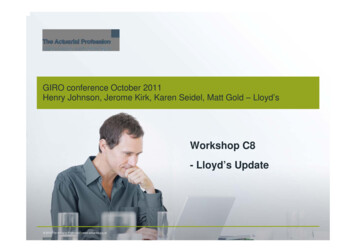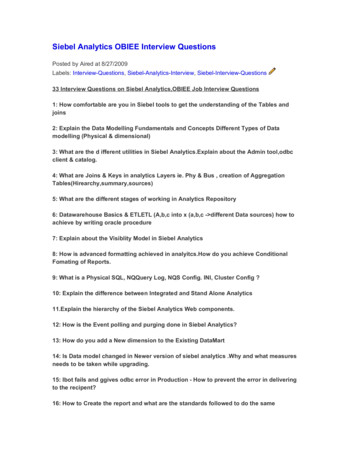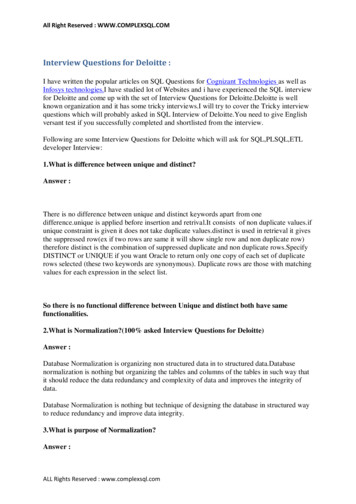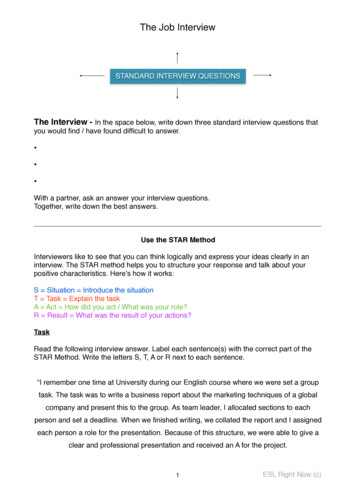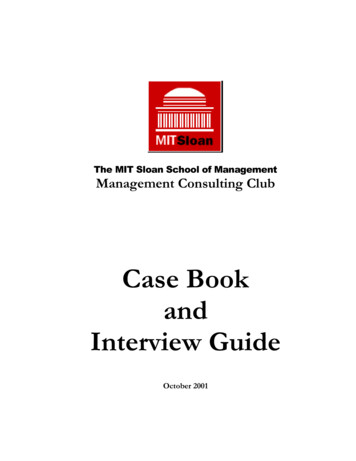
Transcription
Director’s MessageEvolution of a ClinicianAlcoholics Anonymous:A Self-PsychologicalPerspectiveAn Interview with KirkJames, DSW’13, MSWVolume 4 Issue 1 Winter-Spring 2014The ClinicianThe Clinical Doctor of Social Work NewsletterThe University of Pennsylvania School of Social Policy & PracticeDSW’14 Graduates - Jennifer Fulton, Christin Gregory, Charisse Marshall, Monica Smith & Darcella SessomesThe Clinician is a Student and Alumni Run Newsletter website: ml
Volume 4: Issue 1CONTENTS3.Director’s MessageCongratulations Jennifer Boyle and Pier CicerelleRecipients of the 2014 Dr. Ram Cnaan AwardLina Hartocollis, MSS, PhD5.Evolution of a ClinicianBy Sophie Nadkarni, DSW Candidate, LCSW6.Alcoholics Anonymous: A Self-Psychological PerspectiveBy Noah Kass, DSW Candidate, LCSW9.Alumni UpdateAn Interview with Kirk James, DSW’13, MSWBy MaryAnn A. Groncki, DSW, LCSW10.DSW Student and Alumni NewsWork published in The Clinician is not copyrighted bythe newsletter. Publication in The Clinician does not limitthe publication of work submitted and published in thenewsletter in other venues. Opinions and ideas expressedby the contributors are their own and not necessarily thoseof The Clinician editorial group, the School of Social Policy &Practice, or the University of Pennsylvania. Submissions mayhave been edited to conform to newsletter style and format.2. The Clinician Volume 4: Issue 1 (Winter-Spring, 2014)The ClinicianThe Clinical DSW NewsletterEXECUTIVE EDITORMarni Rosner, DSW, LCSWEDITORIAL COMMITTEEMaryAnn A. Groncki, DSW, LCSWNoah Kass, DSW Candidate, LCSWMegan K. Schutt, MSW, ACSWGRAPHIC DESIGN & LAYOUTPAST EXECUTIVE EDITORMaryAnn A. Groncki, DSW, LCSWWe would like to take this opportunity tothank everyone who has contributed to thisedition of The Clinician. A very special thankyou to Dr. Lina Hartocollis for her ongoingsupport and contributions to The Clinician.
DIRECTOR’S MESSAGELINA HARTOCOLLIS, MSS, PHDWe just completed a summative evaluation of the DSW program, basedon a survey of our alumni and on data from program records. Althoughthe evaluation was part of our ongoing continuous improvement efforts,several colleagues and I wrote-up the results in an article that will bepublished later this year in the Journal of Teaching in Social Work, in aspecial issue on doctoral education. We wrote the article so other programsthat are considering a DSW could learn from our experience as the firstof the new social work practice doctorates. Here’s a snapshot of what wefound.The DSW program’s retention rate is 91%, with 106 students havingstarted the program since we opened our doors in 2007. As for completionrates, 71% of our students finished the degree in three years, and 86%completed by year five. This compares favorably to the approximately 67%of social work PhD students in this country who finish the degree by year 7(Sowell, 2008).The anonymous alumni survey, which had a healthy 82% response rate, asked program graduates whether theDSW had helped them in their practice, opened career doors, and prepared them for teaching jobs. It was veryinteresting (and gratifying) to hear what our graduates had to say.Several remarked on the value of having the doctoral credential:The credential and newfound area of expertise improved my professional satisfaction and status.I get more respect from colleagues in other disciplines, such as psychiatrists, who will return my calls because I cansay “Dr.” in front of my name now.I think having the credential has helped me gain confidence in collaborating with colleagues from otherdisciplines.I didn’t change jobs but I had additional job opportunities at my current place of work as a result of the DSW.Others spoke of the power of the credential combined with the knowledge and expertise they had gained:I have been transformed from a regular clinician to expert practitioner equipped with advanced knowledge andskill I also call myself “Dr.,” which earns recognition from colleagues and clients.I think calling myself doctor has increased my credibility with some of my patients and having a doctorate fromPenn has opened some doors for me. However, it is the substantive expertise that has made the most difference. Ifeel like a more knowledgeable, more effective, “smarter” therapist.I attribute changes in my job to the credential (from an Ivy League University) and to the substantive knowledge Igained from my dissertation.A number of respondents talked about how the DSW enhanced their career mobility:How did the DSW help? One hundred percent! The position I’m now in required a doctoral degree to apply.The Clinician Volume 4: Issue 1 (Winter-Spring, 2014) 3.
DIRECTOR’S MESSAGELINA HARTOCOLLIS, MSS, PHDContinued From Page 3Getting my new job was directly linked to the DSW degree and to networking with my peers and instructors.I attribute my changed position to the DSW. The DSW provided increased flexibility to engage in self-employedprivate practice and do adjunct teaching on the side. Later that allowed me to have the experience to movetoward the full-time teaching position that I now have.A sizable number of our graduates (roughly 70%) are teaching in bachelors and masters programs—at Penn,Bryn Mawr, Stockton, Temple, CUNY, USC (CA), Pitt and Rutgers, to name a few. Most are combining practicewith part-time teaching but some have taken full-time teaching positions.Without a DSW I do not believe I could have gotten a tenure-track position.At this time my job change is directly related to the DSW credential as I am working as an assistant professor.I obtained a teaching and research position while enrolled in the program and I attribute this to the level ofexpertise I gained. I also obtained a tenure-track teaching position post-graduation and I attribute this to thecredentials and the expertise I gained and to the reputation of the school.Finally, we were pleased and a bit surprised to hear how much students liked and valued the dissertationprocess!The dissertation gave me more confidence in my writing and ability to conceptualize mental health issues.I have learned how to do scholarly work, which it turns out I love to do.Completing my dissertation opened doors by legitimizing me as an expert in the field. This has helped menetwork with the very experts who have influenced my studies.I have used the knowledge gained in writing my dissertation in my clinical practice.My dissertation research has impacted how I am seen in my field. I also have received many requests to doworkshops, etc. It has definitely facilitated teaching opportunities.Given our program goals of enhancing the professional status of social work practitioners by preparing doctorallevel practitioner-scholars who generate and disseminate social work knowledge through teaching, scholarshipand practice, I’d say we’re doing quite well.ReferencesSowell, R. (2008). PhD completion and attrition: Analysis of baseline data. Washington, DC: Council of GraduateSchools.4. The Clinician Volume 4: Issue 1 (Winter-Spring, 2014)
EVOLUTION OF A CLINICIANSophie Nadkarni, DSW Candidate, LCSWAs I reflect on my first year as a doctoral student at Penn,I feel that I am part of a larger process of cultivating acohesive identity for the DSW degree. The field of socialwork, in general, has struggled to carve out its own placeand unique identity. As the DSW degree is in its nascence,we have an opportunity to carve out our cultural identityand establish our academic cache. If my experiencecorresponds to that of my peers, I believe that the DSWdegree is multidimensional, integrating advanced clinicalpractice skills, sophisticated research consumptionabilities, and research experience. This degree is asynthesis of these skills, not an accumulation of them.I entered this program as a clinical social worker. Intellectually, I valued the relevance of research, but in practicefelt that it was out of touch with daily authentic applications of clinical work. I came into the program withpersonally constructed and culturally supported beliefs that distinguished clinicians from researchers. To mysurprise - and confusion - from the moment I entered the program, I was addressed and regarded by my professorsas a clinician and researcher. During my second week of class, my research professor looked directly at me andsaid, “So when you write your research proposal, you have to lay out your concepts and operationalize!” I wantedto respectfully reply that I was a psychodynamically oriented clinical social worker who preferred working withpeople over variables. But as the semester continued, I found variables to be quite interesting - especially whenthey related to the variables I wanted to operationalize in my future research (she got me).Research methods course work required in-depth proposals. Days were devoted to breaking down concepts,such as the importance of a well-constructed consent form. I learned that every part of research informs clinicalpractice, and visa versa. Keeping up on evidence-based practice was no longer about reading the abstractand conclusion, hoping to understand the jargon in between. I began to read articles because they raisedphilosophical questions, pointed me towards relevant psychometrics that I could use in my own practice, andguided me towards interventions that worked. Certain articles concluded similarly to a favorite book, wherequestions were left unanswered. I found these articles engaging because I began to feel knowledgeable and savvyenough to take up where the researchers left off. I started thinking like a researcher.Relating to myself as a budding researcher is a significant change in my personal and professional identity.Personally, it feels like a huge accomplishment - the kind I want to call home and tell my mother about.Professionally, I feel far more competent and on par with consumers of research in other disciplines - a winfor clinical social workers. As I began relating to my peers as clinicians, consumers, and researchers, I startedconsidering how our three dimensional identity would contribute to the advancement of social work. Whenlistening to the research interests and methods proposed by my cohort, it became clear that research conductedby DSWs not only represents social work interests but also, and more importantly, will be carried out and designedin ways that reflect the day-to-day challenges of social work settings.This essay does not address the unique ways the DSW program enhances clinical skills, though I hope that goeswithout saying. I am emphasizing and focusing on the integration of research into the clinical social work identity,as its effects have been completely unexpected.I do not view these developing skillsets or identities as three intersecting circles but as a sphere. Now, in thelast week of my first year, I notice that I am always thinking of clinical implications when considering researchquestions as I read an article. I do not switch between these different perspectives nor do I have to make aconscious effort to. I am simply in the process of thinking like a DSW candidate.The Clinician Volume 4: Issue 1 (Winter-Spring, 2014) 5.
ALCOHOLICS ANONYMOUS: A SELF-PSYCHOLOGICAL PERSPECTIVENoah Kass, DSW Candidate, LCSWSelf-psychology, developed by Heinz Kohut, is a psychoanalytictheory that views psychopathology as being the result of unmet ordisrupted developmental needs. Essential to understanding selfpsychology is the concept of selfobjects. Selfobjects are personsor things physically existing outside the self, experienced as partof the self, and that function in service of the self (Kohut, 1984).Selfobjects fulfill mirroring, idealization, and twinship needs.The mirroring need allows the infant to confirm her own specialness and establishes excitement for existence. Theinfant craves appreciation and responsiveness from the caregiver. In an optimal caregiving environment, she willfeel comfortable displaying her grandiose self, highlighting her innate talents and potentialities (Banal, Mikulincer, &Shaver, 2005). Suppressing the child’s unrealistic fantasies and ambition would diminish development of productiveenergy and self-confidence (Goldstein, 2010). If the caregiver responds adequately to the mirroring need, the childgradually accepts the loss of infantile grandiosity and begins formulation of realistic goals (Goldstein, 2010).The idealization need allows the child to draw strength from a caregiver’s power and calmness (Goldstein, 1995). Mostnoticeable between ages of four and six (Berzoff, Flanagan, & Hertz, 2007), this need focuses on the desire to be partof and protected by another (Lessem, 2005). Kohut suggested children go through an evolution from idealizing theirparent to viewing them as individuals with imperfections (Lessem, 2005). Parallel to that process, the child evolvesto recognize her own multi-dimensionality. If the idealization selfobject need is fulfilled, the individual can handledisappointment without impacting self-esteem (Goldstein, 2010). Having parents not attuned to this need or notworthy of idealization could result in narcissistic vulnerability, with the self being overly affected and distorted by theslightest discouragement or setback (Lessem, 2005).The twinship need helps individuals feel less isolated in the world by matching them up with another person likethem (Cushman, 1996). It becomes most relevant during the latency period (adolescence), a time when security innumbers is vital. Fulfillment of this need provides separation from the nuclear family, and formation of a consolidatedsense of self (Kohut, 1984). The goal is development of a person’s ability to form mutually gratifying relationships withothers, and concepts of connection and belonging to the world (Kohut, 1984).Although these three selfobject needs have specific ages where they appear most relevant, they are consistentlyevolving and seeking gratification throughout the life cycle. In addition, the extent to which these selfobject needsare satisfactorily internalized in childhood becomes a strong predictor of overall mental health in adulthood.Heinz Kohut’s self-psychological perspective supports participation in 12-step programs such as AlcoholicsAnonymous (AA). Participation in AA often brings a sense of connectivity, safety, and support. Membership in thiscommunity can provide an opportunity for an addict to acquire a substitute selfobject, filling an unmet need frominfancy and childhood (Graham & Glickauf-Hughes, 1992).AA may serve as an “omnipotent transitional object” (Dodes, 1990), an integral ingredient in helping make thetransition from ingesting self-soothing compensatory substances to sudden abstinence bearable. When AA membersspeak about their unwavering devotion to “working the program,” they may be speaking less about AA principles andmore about finding an object (AA) strong enough to compete with their drug of choice.6. The Clinician Volume 4: Issue 1 (Winter-Spring, 2014)
ALCOHOLICS ANONYMOUS: A SELF-PSYCHOLOGICAL PERSPECTIVEBY NOAH KASS, DSW CANDIDATE, LCSWContinued From Page 6The theory of self-psychology emphasizes the need for others to help maintain self-esteem, control anxiety,and provide self-soothing functions (Goldstein, 1995). Long-term AA membership combined with significantimmersion in the fellowship may partially fulfill the idealization, mirroring, and twinship needs not properlyinternalized in addicts during childhood. Since it is difficult to fully meet needs that were unmet in childhood,many recovering addicts feel an almost “addictive” relationship with AA. Perhaps the more one attends, the morethe needs of the tripolar structure (idealization, mirroring, twinship) will be fulfilled. Veterans of AA suggestnewcomers attend 30 meetings in 30 days, supporting this hypothesis.AA attempts to fulfill the addict’s mirroring need through admiration and validation (Levin, 2001). Designatedtime periods (30 days, 90 days, 180 days, 365 days, etc.) are constructed to acknowledge members have achievedsignificant abstinence from their drug or addictive behavior of choice. At these times, members explicitly reflectand voice recognition of the individual’s growth during the recovery process; a coin may be given representing theamount of sober days; and the individual may be given new membership responsibilities. The celebrated memberis recognized, validated, and admired by peers.In AA, the addict is given the time to freely share thoughts, feelings, and experiences without interruption. Thispromotes, rather than represses, a natural grandiosity often unacknowledged by the individual’s primary caregiver.It is a relief from the repression of emotions that often occur during active addiction.The mirroring self is seen as the addict begins to recognize like-minded individuals inside the various AA rooms.Often she is surprised by the lack of judgment from fellow addicts. This experience may have a transformationalimpact. They have located others in the world who have shared experiences, and with that comes a unique senseof acceptance and familiarity (Robinson, 1997). These like-minded individuals help lessen the shame associatedwith previous addictive behaviors.Peers begin to see how voicing their own experiences can help each other. They become sponsors to newcomers,helping guide them through the AA traditions and principles. This continues an everlasting mirroring process,allowing the sponsor to continue having her own thoughts, feelings, and experiences, recognized and reflectedback to her by the sponsee.Alcoholics Anonymous attempts to fulfill the idealization need by providing an organization to admire and identifywith. It serves as a re-parenting mechanism substituting for the original idealized parental imago (Robinson, 1997).In the program’s principles and procedures, members recognize organization and productivity.In its focus on simplicity and consistency, members recognize calmness and rationality. These features were usuallynot seen in the addict’s relationship with her primary caregiver.The hopefully productive sponsor/sponsee relationship makes vivid the often-problematic relationship of thecaregiver/child. It is the hope that the sponsor, through example, can provide the addict with what the caregivercould not: the ability to be simultaneously productive and free from destructive anxiety. The prescriptive natureof AA, including working the steps, attending meetings regularly, getting a sponsor, and abstaining from drugs/alcohol, is reminiscent of a parental figure giving practical and compassionate advice to a child. The focus on ahigher power, sponsor, group members, and the entire collective could help mirror selfobject functions previouslyattempted by the isolated individual (Dodes, 1990).The power of the fellowship is recognized as existing beyond any individual room, extending across states andcountries. Individuals are given a common language to communicate with a diverse population whose similaritiesbind them together. The addict feels less isolated in this world, the exact opposite of what she may have felt whenin the cycle of active addiction.The Clinician Volume 4: Issue 1 (Winter-Spring, 2014) 7.
ALCOHOLICS ANONYMOUS: A SELF-PSYCHOLOGICAL PERSPECTIVEBY NOAH KASS, DSW CANDIDATE, LCSWContinued From Page 7ReferencesBanal, E., Mikulincer, M., & Shaver, P. R. (2005). “Selfobject” needs in Kohut’s self psychology: Links with attachment,self-cohesion, affect regulation, and adjustment. Psychoanalytic Psychology, 22(2), 224.Berzoff, J., Flanagan, L. M., & Hertz, P. (2007). Inside out and outside in: Psychodynamic clinical theory, practice andpsychopathology in multicultural contexts. Lanham, Maryland: Rowland & Littlefield.Cushman, P. (1996). Constructing the Self, Constructing America: A Cultural History of Psychotherapy. Cambridge,MA: Da Capo.Dodes, L. M. (1990). Addiction, helplessness, and narcissistic rage. Psychoanalytic Quarterly 59(3), 398–419.Goldstein, E. G. (1995). Ego Psychology and Social Work Practice. New York: Simon & Schuster.Goldstein, E. (2010). Object Relations Theory and Self Psychology in Soc. Simon and Schuster.com.Graham, A., & Glickauf-Hughes, C. (1992). Object relations and addiction: The role of ‘transmuting externalizations.’Journal of Contemporary Psychotherapy 22(1), 21–33.Kohut, H., & Stepansky, P. E. (1984). In A. Goldberg (Ed.), How does analysis cure? Chicago: University of ChicagoPress.Lessem, P. A. (2005). Self psychology: An introduction. New York: Jason Aronson.Levin, J. D. (2001). Therapeutic strategies for treating addiction: From slavery to freedom. New York: Jason Aronson.Robinson, C. M. (1997). Alcoholics Anonymous as seen from the perspective of self psychology. Smith CollegeStudies in Social Work, 67(2), 129–145.Congratulations Cynthia Closs, DSW’10, LCSWRecipient of the 2014 Excellence in Teaching Award for Part-Time FacultyUniversity of Pennsylvania, School of Social Policy & PracticeThis is the second consecutive year that Dr. Closs has received the Excellence inTeaching Award for Part-Time Faculty at SP2. In addition to teaching and non-profitwork, Dr. Closs is the Coordinator for the Sexual Assault Counseling and EducationUnit at Temple University’s Tuttleman Counseling Center. She also maintains aprivate practice in Center City, Philadelphia. Dr. Closs has taught courses on mentalhealth diagnostics, human behavior and the social environment and anxiety anddepression. She has given a number of lectures and presentations on best clinicalpractices when working with folks of trans* experience. For the past 16 years, she hasworked with the queer, trans* and HIV communities. Dr. Closs is specifically interestedin relational and trauma theory and practice and her clinical work focuses on personsliving with HIV disease, trauma, addiction, and young adults who identify as queerand of trans* experience.8. The Clinician Volume 4: Issue 1 (Winter-Spring, 2014)
ALUMNI UPDATEAn Interview with Kirk James, DSW’13, MSWB Y M A R YA N N A . G R O N C K I , D S W ’ 1 0 , LC S Wholistic service and advocacy in line with our organizing value ofsocial justice.The first semester of the curriculum provides a historical andcontemporary analysis of the problem. The second semesterexamines challenges to clinical practice with people impacted bythe criminal justice system, as well as clinical theories that haveproved to have empirical validity and cultural competency intreatment settings.Could you tell us about the Goldring Reentry Initiative and yourrole in it?KIRK JAMESSP2 DSW GRADUATE (2013)Your dissertation, “The Invisible Epidemic:Educating Social Work Students towardsHolistic Practice in a Period of MassIncarceration” (2013) introduced a twosemester MSW curriculum which infusedsocial work education with issues relatingto mass incarceration and its variousintersections with social work practice.Could you tell us about the two-semesterMSW curriculum?I developed the two-semester curriculumbased primarily on my personal andprofessional experiences as a socialworker. In an era where more people areincarcerated than any other point in thehistory of the United States, I have alwaysbeen saddened by social workers’ anemicresponse to the issue. The curriculumposits that the intersection of social workpractice and issues (i.e., housing, mentalhealth, education) of mass incarceration areinextricable linked; thus it is imperative thatsocial work students have a more holisticunderstanding of the problem to provideDr. Ram Cnaan and I created the Goldring Reentry Initiative(GRI). Ram had begun to do some work around mass incarcerationand was astonished that such a huge social justice issue wasnot being addressed in the social work community. He was alsoshocked that so many people went back to prison after release(ranging from 40 to 70% in 3 years).Dr. Cnaan hypothesized that social work students working inthe prisons with men and women both 3 months pre and postrelease could lower their likelihood of recidivism.We secured funding through SP2 board of trustee memberGary Goldring. The first year we worked with almost 100 peoplebeing released from Philadelphia prisons with varying degreesof success. Students and prison administrators both love the GRI.Like any new program, it will grow and evolve as we learn aboutwhat works and what doesn’t. This initiative is an important socialwork response to what I believe is the greatest social justice issueof our generation.Could you tell us about the Fortune Society and your role in it?I began working at the Fortune Society on March 7th asthe senior director of policy. This may be a bit puzzling since Ijust finished a clinical doctorate, yet I believe that my clinicalbackground makes me ideal for this work. The Fortune Societyis a large direct service agency that serves almost four thousandpeople impacted by the criminal justice system each year. Wealso utilize our clients’ narratives and experiences to inform policyand advocacy. Issues of trauma and its impact on behavior (viaThe Clinician Volume 4: Issue 1 (Winter-Spring, 2014) 9.
An Interview with Kirk James, DSW’13, MSWBy MaryAnn A. Groncki, DSW’10, LCSWContinued From Page 9neuroscience research) have been largely overlookedin the conceptualization and implementationof policy. I aim to bring about a more clinicalunderstanding of behavior deemed criminal, and toutilize that information in our advocacy and policywork.How did your education influence your thinkingabout this program?I was able to take a more holistic look at behavior,especially the utilization of neuroscience research tobetter understand the impact of trauma (pervasiveamongst CJ populations) on the brain and itsconnection to behavior.What experiences as a Clinical Doctor of Social Workstudent and candidate at UPenn have been the mostvaluable for you?M A R YA N N A . G R O N C K ISP2 DSW GRADUATE (2010)I have had so many valuable experiences, but without a doubt my DSW cohort. They are an amazing group ofhuman beings who pushed and supported each other’s professional and personal growth. It was an experiencethat I will always cherish.Additional Information About Dr. Kirk James:Dr. Kirk Anthony James Senior Director, David Rothenberg Center For Public Policy The Fortune Society 29-76Northern Boulevard Long Island City, NY 11101 Phone: 347.510.3617 Fax: 212.633.6845 Website:www.fortunesociety.orgThe Clinician, published twice yearly, provides UPenn DSW students and alumni an opportunity tohighlight their work, research, and thinking as it relates to direct practice and leadership in the socialwork profession. We encourage submission of articles that encompass social work values, are innovativeand creative, and represent a wide range of clinical paradigms and techniques. We also encouragesubmission of essays and reflections that are relevant to clinical practice and leadership in social work.To view previous issues of The Clinician click on the following link mlClick on any of the hyperlinks in this issue of The Clinician to be taken directly to the site.DSW STUDENT AND ALUMNI NEWSJane Abrams, DSW’10, LCSW, co-authored the article “Teaching Trauma Theory and Practice in MSW Programs: AClinically Focused, Case-Based Method”, published in the Clinical Social Work Journal. She has been accepted intothe Psychoanalytic and Psychodynamic Teachers’ Academy of the American Psychoanalytic Association for 2014.Along with five other teachers selected for the Academy - social workers, psychologists and psychiatrists –sheattended sessions with master teachers at the annual meeting of APsaA in January and will receive one-on-one10. The Clinician Volume 4: Issue 1 (Winter-Spring, 2014)
DSW STUDENT AND ALUMNI NEWSmentoring with a master teacher throughout 2014. She continues as a part-time lecturer at SP2, teaching twocourses: Social Work Practice and Trauma, and Psychodynamic Theory for Clinical Social Work. She served asmentor this academic year for three DSW students in the current cohort. Dr. Abrams maintains her privatepsychotherapy practice in Center City, Philadelphia, specializing in treating adults and couples and providingclinical supervision.Pier Cicerelle, DSW Candidate (ABD), LSW, will be teaching a new class at West Chester University beginning thissummer. The class, for which she created the curriculum and syllabus, is “Special Topic: Social Work in Health Care”.Michael Crocker, DSW’13, LCSW, MA, is an adjunct professor at The Touro College Graduate School of Social Work.He will present “Sexuality, Attachment and Trauma: Helping Clients with Sexual Compulsivity Find Their Way Backto Healthy Attachment” at the NASW Addictions Conference on June 11th, 2014. This presentation is based onhis dissertation, which researched the relationship between Hypersexual Behavior and Attachment Styles. Thepresentation will provide an overview of the results of this research as well as the treatment approach of his grouppractice: The Sexuality, Attachment and Trauma Project.JaNeen Cross, DSW Candidate, LSW, ACSW, MBA, presented the workshop “When NICU Children Aren’t Safe atHome” at the National Association of Perinatal Social Workers (NAPSW) Conference in San Antonio, Texas this pastMay. She also received a Penn Medicine’s CARES community outreach grant to support the efforts of the NICUParent Peer Support group. Janeen helped to develop and currently manages this group.Deborah O’Neill, DSW’12, LCSW, created a sexual trauma treatment outreach and prevention team (STTOP) at theUniversity of Pennsylvania Counseling and Psychological Services (CAPS). The mission of this team is to provideconfidential care, support, and advocacy for students who have experienced sexual trauma during their academiccareer. It is based on Dr. O’Neill’s dissertation research, which focused on college cam
James, DSW'13, MSW DSW'14 Graduates - Jennifer Fulton, Christin Gregory, Charisse Marshall, Monica Smith & Darcella Sessomes . are teaching in bachelors and masters programs—at Penn, Bryn Mawr, Stockton, Temple, CUNY, USC (CA), Pitt and Rutgers, to name a few. Most are combining practice with part-time teaching but some have taken full .




